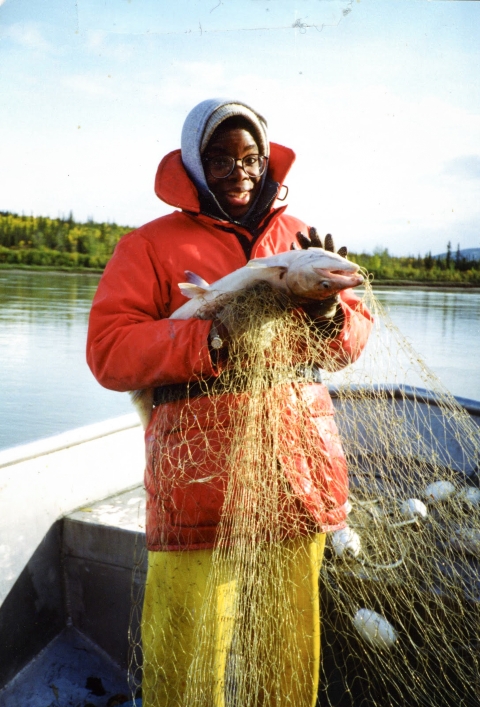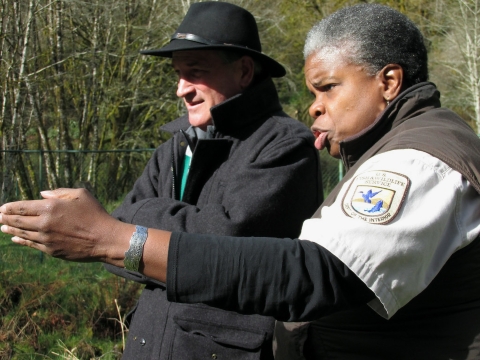Born in Manhattan and growing up in Brooklyn, Judy Gordon discovered the natural world while exploring the ocean with Jacques Cousteau on television. She watched with rapt attention as Cousteau and other biologists jumped into Zodiacs and zoomed around the ocean, a world far removed from the cityscape surrounding her.
She remembers the first time her mother took her and her sister fishing in Prospect Park in Brooklyn when she was 6 years old, and the excitement of reeling in her first fish. She was curious about the nature she noticed in the city and was a regular contributor to science fairs at school with a specific interest in biology.
She knew, even at that young age, that she wanted to do something in this field. Those early experiences led Gordon to a life in fisheries conservation.
Gordon’s family moved to New Jersey where she attended high school. She went on to earn her bachelor’s degree in biology from Princeton University, then to earn a master’s degree in quantitative ecology with a minor in statistics from Pennsylvania State University.
Gordon’s childhood fascination with Cousteau became reality while in graduate school, as she voyaged into the realm of ocean research by making her first strides into conservation with NOAA Fisheries. She would sometimes spend long stretches on research vessels at sea; she’d face extreme weather, even hurricanes, yet Gordon is clear that she would do it again in a heartbeat.
“There is a moment, whether the sea is perfectly glass smooth or whether there’s 30-foot waves, and you’re this big – and you realize mankind is this big,” Gordon says with her hand up, two fingers measuring about an inch of air.
“Some people might say they hear God in that moment…it’s a humbling, amazing experience.”
It was a dream come true. She loved being at sea.
But when NOAA did not have the funding to keep her on permanently, one of Gordon’s grad school committee members suggested she look into joining the U.S. Fish and Wildlife Service. Gordon landed a permanent position in Fairbanks, Alaska to conduct fisheries work in the nearshore waters of Arctic National Wildlife Refuge. She was one of a handful of women she knew in her field within the state at that time.
Women and people of color were, and still are, in the minority of the fisheries workforce. But Gordon had women to look to as role models along the way, and one of them became an especially important mentor, just as she was navigating her first permanent, federal job with the Service.
Jaqueline “Jackie” LaPerriere, a prolific limnologist – scientist of freshwater systems, encouraged Gordon and reminded her to “take no guff.” LaPerriere has since passed, but Gordon remembers her as a wonderful person and a dear friend who landed in her life at just the right time.
LePerriere was someone who really made a difference.
“Jackie was a friend, mentor, and fierce supporter,” Gordon said. “As an established female limnologist, she was well aware of the challenges facing many younger women just starting their careers in male-dominated science professions. She was also sensitive to the professional climate in Alaska and specifically in the office I was working in. Jackie had worked with the male fish biologists and knew the previous sole female biologist in the office. Her support and insights into the professional relationships were invaluable for me starting in my first permanent position and 3,000 miles from everything I was familiar with.”
The mentors and champions throughout Gordon’s career were essential to supporting her successes and challenges along the way.
Vivid in her memory, Gordon shared details about a challenging time from early in her career when one of her coworkers treated her unequally from her peers. This coworker would disregard her while acknowledging her male counterparts; he would not include her, work with her, or even say hello. His behavior was incessant and made going to work difficult for Gordon and impacted her ability to do her job.
Yet, Gordon stayed committed to doing right. Every day this coworker would greet her male colleagues and say nothing to her. But as he turned around to walk away, she would say, “Good morning,” to him, no matter what.
Gordon reflected that overcoming this difficult situation took resolve, patience and perseverance, support from her friends and female colleagues and mentors like LePerriere, and ultimately a supervisor who had observed the behavior, acknowledged it, and assured it was being addressed. He was an advocate for Gordon, a true ally.
“One person can make a difference,” she says. “But you still need to find it within you…to have that strength. But that one person can give you the space to find that strength.”
Now with nearly 40 years of federal service under her belt, many of these in leadership roles, Gordon can see the not-so-distant horizon of the end of her career. During these years, Gordon has held positions that included experiences on ocean-going research vessels to the nearshore waters of the Arctic National Wildlife Refuge, from the Abernathy Fish Technology Center to the Pacific Regional Office, and now overseeing the entire Fish and Aquatic Conservation program of the Pacific Region. And over the last decade or so, she’s experienced a shift, that she herself has become a role model, mentor, and champion for others.
In a self-effacing realization, she recognizes that sometimes you can be a mentor to someone and not even realize it.
“I just wanted to be a fish biologist. I didn’t want to be the ‘Black, female fish biologist.’ But it does matter that I am…it matters to people.”
But Gordon says that at the end of the day, it is not about her. It’s about the bigger picture of conservation.
Gordon recognizes the challenges of conservation for the next generation, particularly in the face of climate change climate change
Climate change includes both global warming driven by human-induced emissions of greenhouse gases and the resulting large-scale shifts in weather patterns. Though there have been previous periods of climatic change, since the mid-20th century humans have had an unprecedented impact on Earth's climate system and caused change on a global scale.
Learn more about climate change . She emphasizes that it will take perseverance, patience, and acknowledgment of the challenges to make strides ahead. She sees that the next 50 years are going to be very different and asks, “What are we going to do now and going forward? How are we going to think outside the box to deal with the huge issues facing us going forward?”
Gordon hopes she will leave the next generation of conservationists equipped to do the work.
“I remember coming to this region in ’98 and I was one of the youngest people in the room – now I’m one of the oldest. Time passes. I’ve done my part to the best of my abilities. We need some fresh approaches and fresh minds.
“In the time I have left before I go, I will try to empower people as much as I can, in the little ways I can. I hope that I did my part to make sure the people who do the work that matters got it done.”





